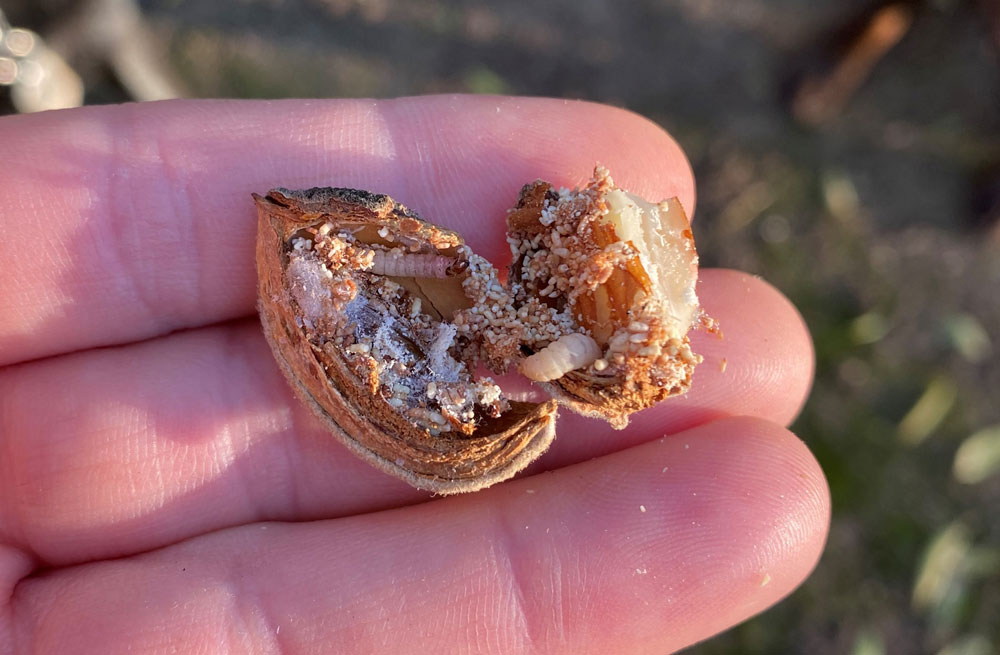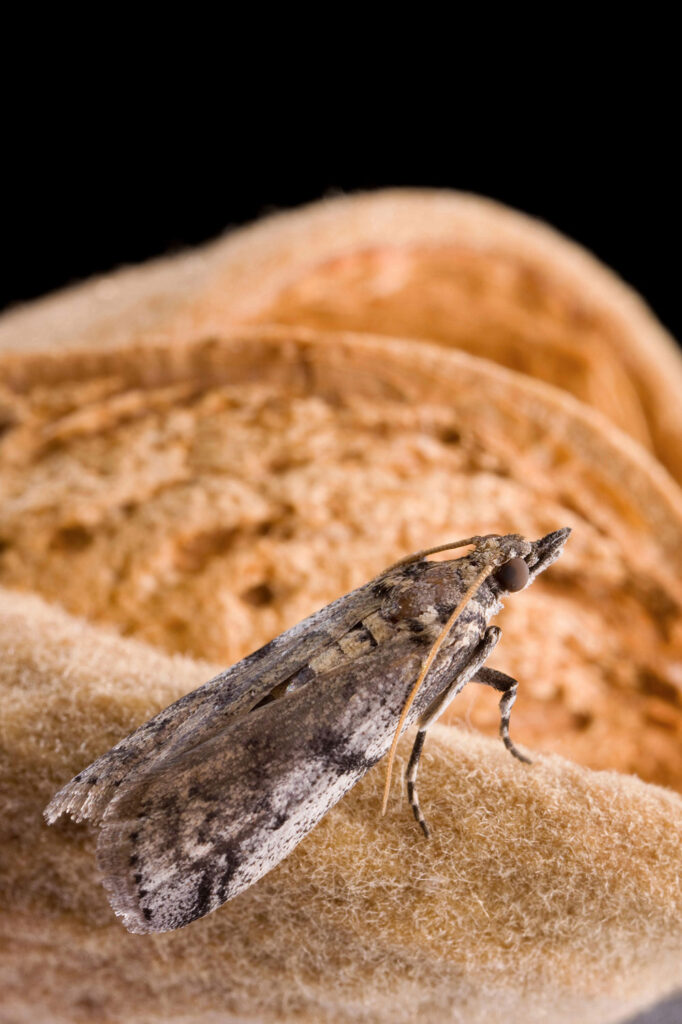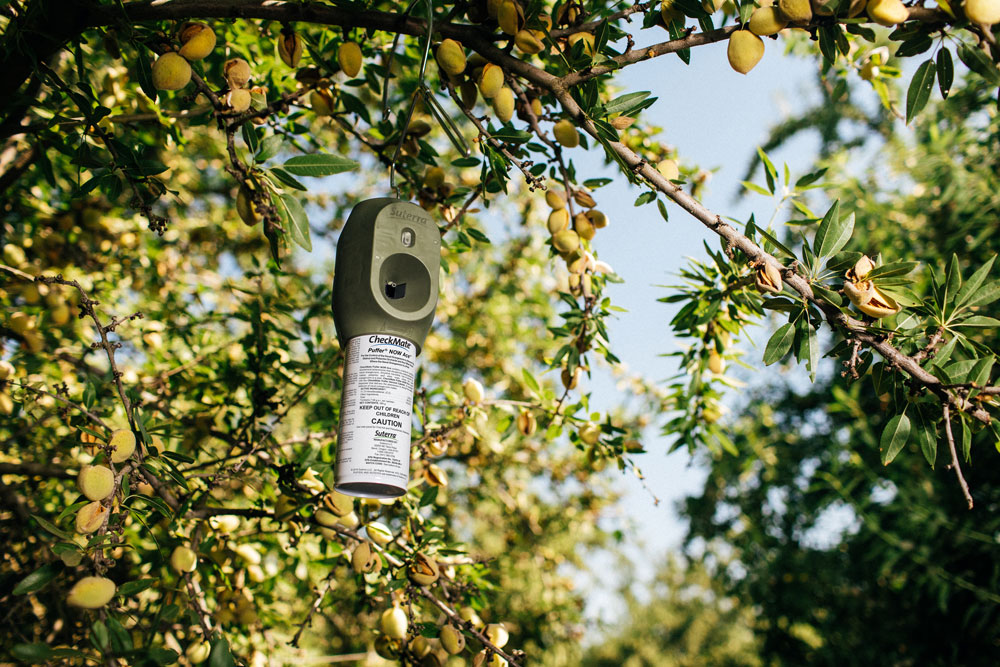
The 2022 growing season will likely continue to present uncertainties around supply chain, availability of critical crop inputs like fertilizers, costs of materials and access to labor, among others. One unfortunate certainty that California nut crop growers have come to expect is the potential for navel orangeworm (NOW) to cause economic damage in almonds, pistachios and walnuts. For the past several decades, NOW has been a primary insect pest in these crops.
Despite the perennial threat of NOW, the outlook for this pest is increasingly encouraging. Advances in research and technology, coupled with historically proven practices, have equipped growers and their crop advisers with options to develop customized and effective integrated pest management (IPM) strategies for NOW in their orchards.
Mating disruption is one technological advancement that provides nut crop producers with an additional effective tool to reduce NOW populations, protect yields and deliver a high-quality crop. Recent estimates indicate that approximately 40% of almond acreage and 50% to 60% of pistachio acreage are using some form of mating disruption. Adoption rates are increasing year over year as successes and return on investment are realized. Multiple years of industry and academic research has shown that incorporating mating disruption into an IPM program for NOW will reduce crop damage by 50% or more in a single year with further reductions over multiple years of use.
In addition to the direct benefits of mating disruption, it is important to note that this approach increases the efficacy and return on investment of other pest management tactics because there are fewer pests in the environment to kill or remove with insecticides and other inputs.
Insect Behavior Modifier
In the case of NOW specifically, mating disruption works by inhibiting the ability of male NOW to locate females for reproduction. This non-toxic mode of action reduces the number of viable offspring in each generation that pheromone mating disruptants are effective in the orchard.
The physiology of pheromone-based communication among insects and the behaviors elicited are highly specific to a given species and innately tied to their evolutionary success. For this reason, we can exploit this part of their biology for purposes of pest management, reducing populations in a consistent and reproduceable manner with mating disruption products.
Population Potential and Mating Disruption
Population growth rates in insects when uncontrolled can be exponential, given the high reproductive potential of each individual female. For example, consider a basic model for NOW population growth rates assuming an initial population of 100 individual NOW, a 50:50 male-to-female sex ratio in the population and an average of 100 eggs per female (a conservative estimate for NOW.) In the absence of mating disruption and other mortality factors, this would result in 250,000 NOW in the second generation, 12.5 million NOW in the third generation, and 625 million NOW in the fourth generation.
With highly effective mating disruption (95% reduction in offspring each generation), those numbers become 625 in generation two, 1563 in generation three, and 3906 in generation four. If mating disruption increases to 98% reduction in offspring each generation, the model demonstrates a negative population growth rate, with 50, 25, and 13 offspring in generations two, three, and four, respectively. While this model does not account for natural mortality, induced mortality (e.g., insecticide inputs during the season), sanitation efforts impacting the initial population density, or migration into or out of the orchard, the trajectory of each population potential growth curve remains consistent and illustrates the efficacy of mating disruption.
Sanitation Remains a Critical Baseline
The model above is based on an initial population of 100 individual NOW. Layering in other critical baseline IPM inputs such as sanitation will impact the initial population density and ultimate NOW numbers each generation, although population growth models will remain consistent depending on whether mating disruption is included or not.
Consider sanitation efforts that result in an initial population of 15 individual NOW rather than 100. Under the same model assumptions as above, without mating disruption, the population potential is 1.875 million NOW in generation three. With highly effective mating disruption, 586 third generation NOW will be possible, and with excellent mating disruption that number drops to 4. This further illustrates the value of a comprehensive IPM program for NOW and the impact of incorporating mating disruption and sanitation as baseline tactics.
Monitoring for NOW in Mating Disrupted Orchards
Monitoring to obtain knowledge for decision-support is crucial for any IPM program. There are several options for monitoring NOW and understanding the utility of each method is important, especially in mating disrupted orchards. Research has shown that a combination of monitoring methods is the best strategy for informing NOW control input needs and timing. In mating disrupted orchards, the presence of pheromone in the environment impacts male capture in traps baited with only pheromone lures; therefore, additional reliance on alternative monitoring approaches is needed. Below is a brief summary of how different monitoring methods can be used in mating disrupted orchards.
Pheromone traps target adult males only and should be deployed in mating disruption blocks to indicate mating disruptant activity.
Significant trap suppression in each flight is expected for season-long products (aerosols and medium-density emitters) and for up to 30 days after application of sprayable pheromones. Increases in pheromone trap capture can inform best timing for application or re-application of sprayable pheromones.
Egg traps can be used in mating disrupted orchards as they are used in non-mating disrupted orchards because female trap location ability is not impacted by mating disruption. Utility of egg traps includes establishing biofixes, degree-day modeling and informing insecticide timing. Egg traps are not an effective method to measure mating disruption efficacy as females lay eggs whether they have mated or not, meaning eggs deposited on egg traps may or may not be viable.
Kairomone (e.g., bait bag or Peterson traps) can be used in mating disrupted orchards in the same way as they are used in non-mating disrupted orchards because female trap location ability is not impacted by mating disruption. These traps target adult females almost exclusively and are considered less sensitive than pheromone traps, meaning they have a smaller attractive radius and often catch a much lower total number of moths relative to pheromone traps, where mating disruption is not present and suppressing pheromone trap capture. Kairomone-based traps can be used to track female flight activity under mating disruption but have not been shown to indicate efficacy of mating disruption.

PPO+Pheromone traps are presently considered the most effective for monitoring NOW flights in mating disruption blocks. Phenyl propionate (PPO) lures paired in a trap with a standard NOW pheromone lure attract both males and females and are used to track flight activity in mating disrupted orchards. PPO+pheromone trap data has not been shown to be indicative of mating disruption efficacy.
Mummy samples and infest rates should be conducted during the late fall to winter to help guide sanitation priorities and estimate block-specific pest pressure going into the next season. This knowledge can help inform mating disruption approaches and plan other NOW control strategies.
Crop phenology is monitored to determine peak in-season crop vulnerability (e.g., the onset of hullsplit through harvest in almonds) and can be paired with visual observations of egg laying directly on the crop. This window of in-season crop susceptibility is a critical time for potential insecticide applications as well as possible targets for timing sprayable pheromone applications.
Harvest damage evaluations are critical to evaluating the overall IPM program. Processor grade sheets provide good information for the grower but may lack specificity regarding the exact nature of damage. Obtaining and cracking out in-orchard harvest samples provides the best information about sources of crop damage as well as a more accurate measure of crop lost to NOW as NOW-damaged nuts may not make it all the way through harvest processes for grade sheet inclusion.
Incorporating Mating Disruption
There are multiple pheromone delivery systems available in the market. Growers and crop advisers are encouraged to investigate each of the pheromone systems in detail and choose a product that best fits the pest management needs of each individual operation. Aerosol emitters (typically one per acre), medium-density dispensers (typically 15 to 28 per acre) and a sprayable microencapsulated formulation (up to 30-day field life) are the three commercially available options. The active ingredient (pheromone) is the same molecule across all NOW mating disruption options. However, even within similar delivery mechanisms (e.g., aerosols), it is important to note that there are intrinsic differences among products. Co-formulants and pheromone purity as well as the device itself (e.g., durability, stability, placement, consistent release mechanism) can result in differences of pheromone release in the environment and thus the effectiveness of disruption in reducing populations and crop damage. The decision on which platform and product is best suited for a given operation should be based on conversations among growers, their PCAs and product manufacturer technical representatives to fully understand the quality, reliability and consistency of pheromone emission.
Keep the Pressure on NOW
It is important to acknowledge that IPM for pests of all types (insects, mites, diseases, weeds and vertebrates) exists within the larger scope of the overall agricultural enterprise. In this context, which could be termed Integrated Production Management (IProM), numerous elements interact to ultimately impact the degree of success in each individual operation. These include, but are not limited to, environmental conditions, water availability and irrigation management, soil structure and health, horticultural characteristics and practices, plant nutrition and pest management, and overall operational activities. In some cases, it may be possible to control or influence these elements to varying degrees. In others like weather conditions, for example, agriculturalists must play the hand dealt. Crop producers are no strangers to this concept and are experts at adapting to challenging and shifting circumstances.

The 2022 growing season will likely present challenges particularly related to the availability of water and fertilizers, both of which not only impact overall plant health and crop yields but can increase the negative impacts of pests and diseases, including NOW. Additionally, if lower crop yields are expected, it becomes increasingly important to the bottom line to ensure that the highest quality crop is delivered in order to receive the maximum premiums possible.
When it comes to the threat of economic damage caused by navel orangeworm, it is critical to continue to manage the aspects that can be controlled. One of the primary features of an IPM approach to pest management is to achieve long-term mitigation of pests and their damage. Mating disruption as a pest management tactic is one that delivers on this concept by driving populations down generation after generation and year after year. Be cautious when considering discontinuing its use, whether due to reduced pest pressure or the need for cost-saving measures due to production and market uncertainties. Consider the longer-term impacts and your investment to date as well as the fact that mating disruption is, at least in part, responsible for downward trends in NOW populations that many growers have been experiencing. Carefully evaluate whether other types of less desirable or more costly inputs can be reduced while maintaining a disruption environment.
Flexibility in mating disruption product choice may be increasingly important in 2022. The choice to commit to season-long products, such as aerosols and meso emitters, is made by early spring. If circumstances in a given operation are extremely uncertain (e.g., water allocation to be able to farm effectively for the entire season), it is reasonable to take a wait-and-see approach for crop input selection. The sprayable pheromone formulation allows for such flexibility. Crop producers can still gain the benefits of a mating disruption mode of action by applying products later in the season targeting one or more specific flights.
Over the course of the past few seasons, we have heard from academics, extension agents, growers and PCAs alike that NOW IPM programs incorporating mating disruption are working to suppress populations and generate quality bonuses, and that the industry should continue to keep the pressure on when it comes to this pest. There are many wonderful resources available for growers, operation managers and PCAs to support successful adoption of mating disruption into your IPM program. Manufacturer technical service representatives, cooperative extension agents and others are readily available to meet with you and help determine the best fit for your operation and how to get the most out of your investment.










